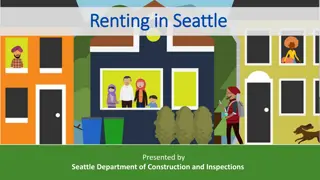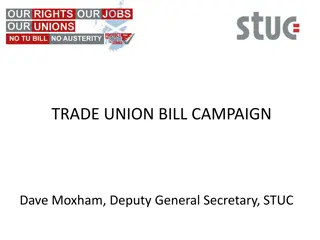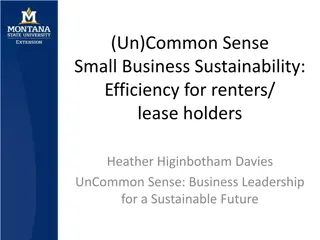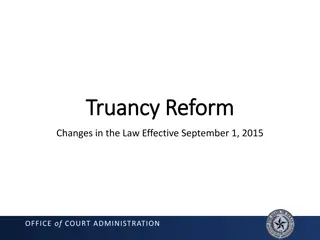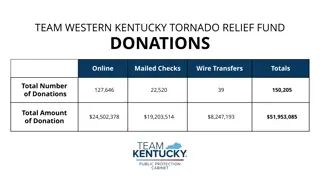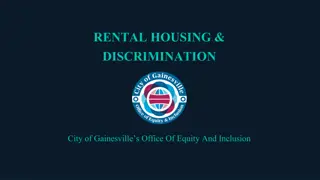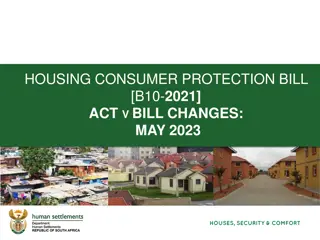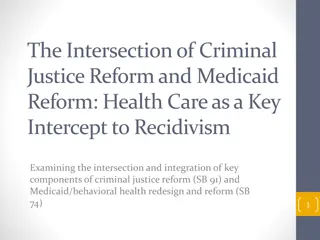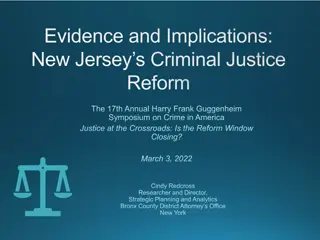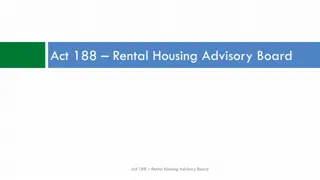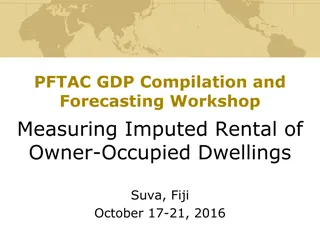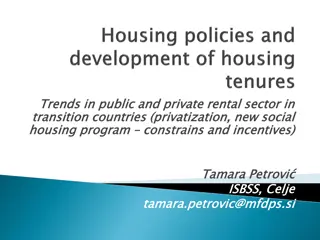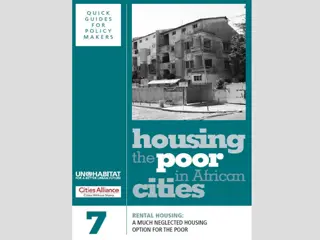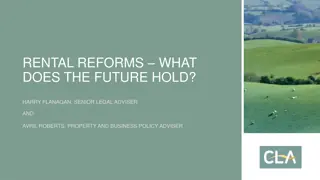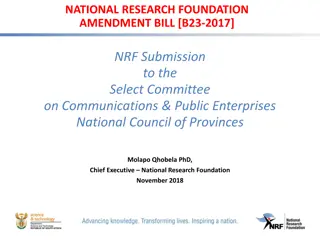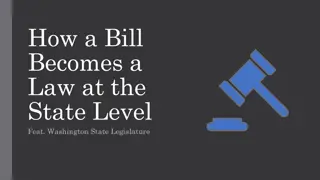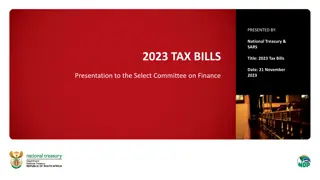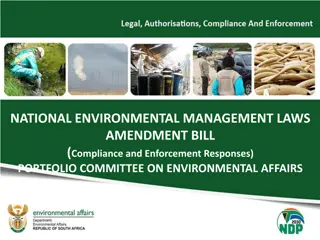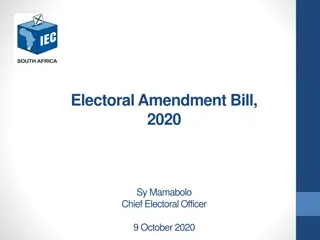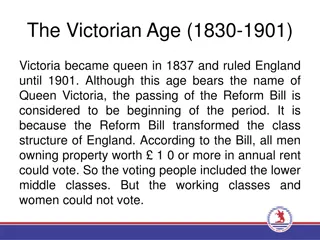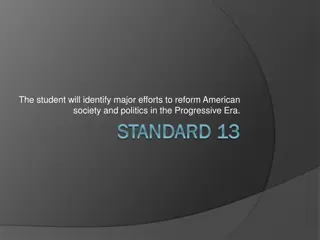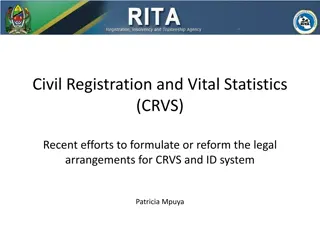Proposed Changes in Rental Laws: The Renters Reform Bill
The Renters Reform Bill is a significant proposal by the government to overhaul private rental laws, promising changes in landlord and tenant rights, duties of local authorities, and court processes. The key highlight is the potential abolition of s21 notices and assured shorthold tenancies. Despite delays in its progression, recent updates suggest a restructuring of the court system to precede any major changes in rental laws.
Download Presentation

Please find below an Image/Link to download the presentation.
The content on the website is provided AS IS for your information and personal use only. It may not be sold, licensed, or shared on other websites without obtaining consent from the author. Download presentation by click this link. If you encounter any issues during the download, it is possible that the publisher has removed the file from their server.
E N D
Presentation Transcript
Safer Renting - Whats been going on ? Ben Reeve-Lewis 1
The Renters Reform Bill This has been promised by government since 2019 and was a manifesto pledge to be the biggest shake up of private rental law since 1989. Published in the spring it proposes a huge raft of changes not only to rights and obligations on landlords and tenants but also to duties of local authorities, in particular placing a duty on councils to prosecute all housing offence breaches (Clause 58) Theoretically taking away negotiations and possibly even warnings. 2
The Renters Reform Bill It also proposes allowing councils to prosecute landlords across borough borders. There are also provision to allow councils to choose to issue civil penalty notices for harassment and illegal eviction as an alternative to prosecution. CPNs are already used for Housing Act 2004 breaches Other proposals in the Bill bring in new grounds for possession where a landlord wants to sell or have his family move in 3
The Renters Reform Bill The provision getting the most attention was the proposal to abolish s21 notices, which would also mean abolition the Assured Shorthold Tenancy, the most common type of tenancy used in the PRS 4
The Renters Reform Bill Despite rushing the Bill through in the spring it was sidelined, much to the concern of tenant s rights groups. Originally expected to have its second reading in the summer but it didn t happen. Second reading took place on Monday 23rd October On 21st October government announced that they would not be abolishing s21 notices until they had completed a restricting of the court system 5
Improving the court system - what it entails digitising more of the court process to make it simpler and easier for landlords to use; exploring the prioritisation of certain cases, including antisocial behaviour; improving bailiff recruitment and retention and reducing administrative tasks so bailiffs can prioritise possession enforcement; and providing early legal advice and better signposting for tenants, including to help them find a housing solution that meets their needs. 6
The Renters Reform Bill What will happen to the Bill now? A general election is looming and government will be concentrating on vote winning strategies so it will highly likely to be kicked into the long grass until after the election. Safer Renting had meetings in August with the shadow housing team who said they would not be amending the Bill if it was passed into an Act before the election. However, if it is still just a Bill at that stage, Labour will probably get their pens out. 7
Deposit protection penalties On the 7th April 2007 a new law was introduced requiring landlords to protect deposits paid on assured shorthold tenancies. Failure to comply with deposit protection regulations allows the tenant to pursue the landlord for not only the return of the deposit also to pay a penalty to the tenant of up to three times the amount of the deposit. They have 6 years to pursue such claims. 9
Deposit protection and Superstrike In 2014 the car case of Superstrike v. Rodriguez went through the courts. This established a principle whereby a deposit protection penalty was available not only when a tenancy commenced but also when a tenancy was renewed. Which also included cases where a fixed term tenancy evolved into a statutory periodic tenancy (s5 Housing Act 1988) at which point this was concerned to be a new tenancy, so the responsibility to protect the deposit arose again. 10
Deposit protection and Superstrike So a deposit taken on the 1st June 2020 needed to be protected in a scheme. If it wasn t then that is cause for a penalty claim. When the tenancy expired at midnight on the 1st June 2021 and became a statuary periodic tenancy, the deposit needs protecting again and if this isn t done a second breach is committed. If for example a tenant signs a new tenancy agreement on the 15th June 2021 the deposit needs protecting again and if it wasn t it constitutes a third breach and a potential third penalty of up to three times the amount of the deposit. 11
Deposit protection and Superstrike So a deposit of 1,500 that isn t protected can allow the court to order the return of the 1,500 plus a possible penalty of 4,500 When the fixed term become periodic a second claim can be made for potentially another 4,500 If, to use our example, the tenancy is renewed with a new contract but the deposit is still unprotected, that is another 4,500. Totalling 15,000 12
Deposit protection and Superstrike Commercial solicitors tend not to take on deposit protection penalty cases and you cant get legal aid for them BUT There is a growing number of Claims farmers coming into the market charging a percentage of the win. The law requires any deposit taken on an AST to be protected within 30 days AND for the prescribed information of the particular scheme to be given to the tenants also within 30 days. Late protection or even returning the deposit to the tenant does not mean the tenant cant claim the penalty. If you miss the 30 day window you cant repair it. 13
Rent inclusive deals Rent inclusive has long been part of the rental landscape, especially in HMOs. Trouble is, 2 years ago nobody foresaw where utility prices would go and many of the standard contracts now leave landlords out of pocket, leading to all manner of arguments over usage and payment 15
Rent inclusive deals A tenancy agreement saying merely Rent inclusive of bills is a weakly worded clause because under law, that encompasses the whole deal and if the bills increase massively, as they have, then the landlord cant demand more money from the tenant. Similarly, a clause stating Rent 500 plus 50 per month for utilities falls into the same trap. The landlord cant demand more than 50 per month because it is a stated clause. 16
Rent inclusive deals In response some landlord are installing lock boxes on thermostats and boilers or using phone apps to control use from a distance but this runs the risk of breaching s1 3(a) of the Protection from Eviction Act 1977 which defines harassment in this context as where a landlord Persistently withdraws or withholds services reasonably required for occupation In addition iti can be source of civil action such as a Rent Repayment Order 17
Rent inclusive deals To get around this you could charge more for utility bills from the outset. Or come to a flexible but enshrined contractual clause on usuage and billing, perhaps dependant on whether a client works from home for instance. Install smart meters for individual rooms. The advantage of this are that each tenant is their own named bill holder and if they leave owing money, the debt goes with them and the landlord is not responsible 18
Rent increase mechanisms You can build a rent increase into a contract, for instance a clause stating the rent will rise by 4% annually. Or by a set amount, say 50 annually. You could simply propose a rent increase and if the tenant agrees and starts paying it then that new rent level is binding. You could issue a new contract at a higher rent and if the tenant wants to sign it then that makes it all official. 20
Rent increase mechanisms Where a fixed term tenancy has lapsed into a statutory periodic tenancy (s5 Housing Act 1988) then to raise the rent you need to serve a formal notice under s13 Housing Act 1988 - free forms are available for download form Gov.uk. You can only do this once every 12 months. The tenant then has one month to refer the increase to the rent tribunal. If the increase is at market rent level they usually don interfere but they can restrict it if it is above. If the tenant doesn t refer it to tribunal then after 1 month the rent increase is allowed. 21






